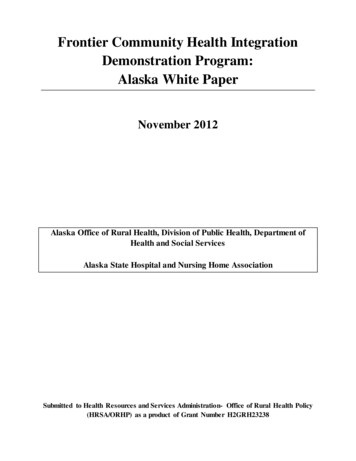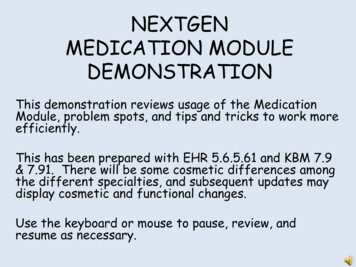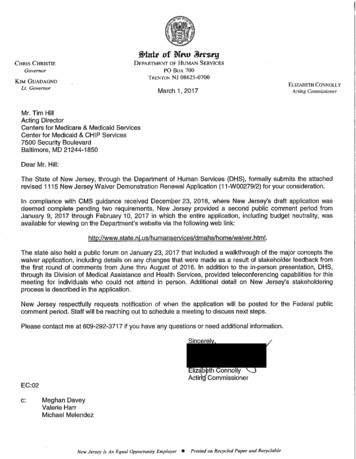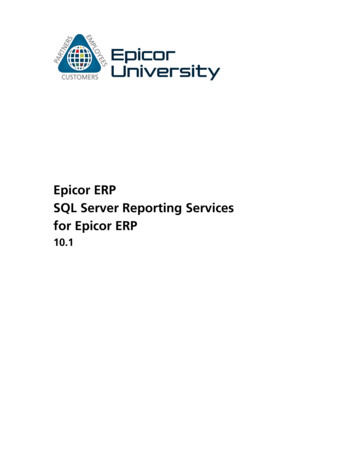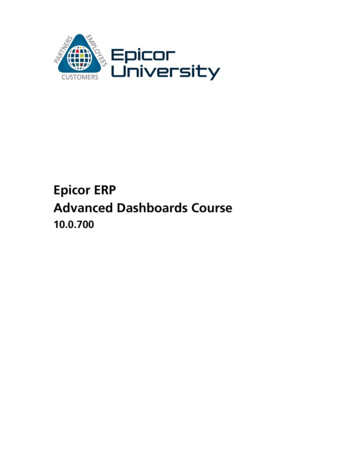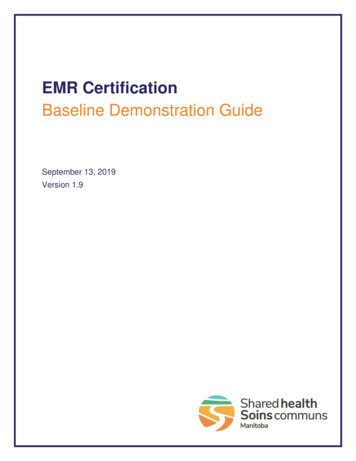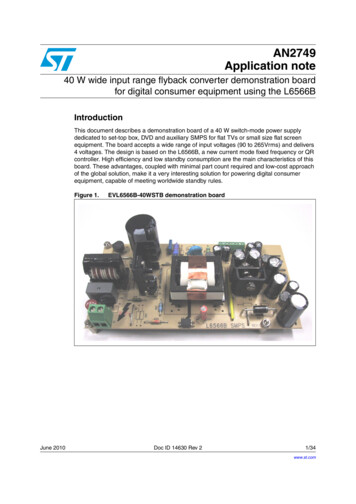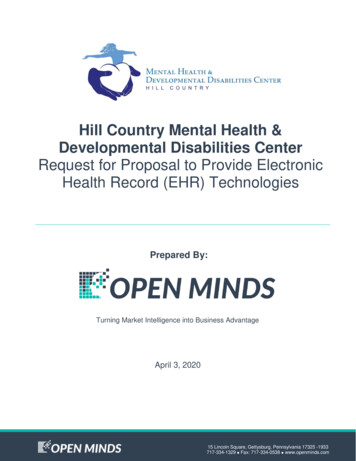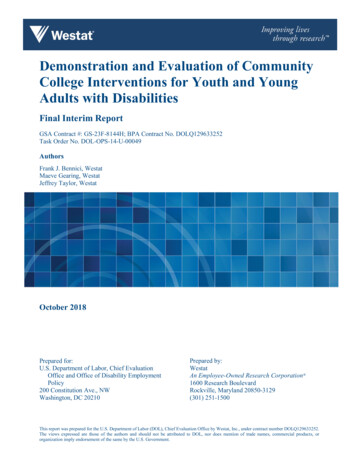
Transcription
Demonstration and Evaluation of CommunityCollege Interventions for Youth and YoungAdults with DisabilitiesFinal Interim ReportGSA Contract #: GS-23F-8144H; BPA Contract No. DOLQ129633252Task Order No. DOL-OPS-14-U-00049AuthorsFrank J. Bennici, WestatMaeve Gearing, WestatJeffrey Taylor, WestatOctober 2018Prepared for:U.S. Department of Labor, Chief EvaluationOffice and Office of Disability EmploymentPolicy200 Constitution Ave., NWWashington, DC 20210Prepared by:WestatAn Employee-Owned Research Corporation 1600 Research BoulevardRockville, Maryland 20850-3129(301) 251-1500This report was prepared for the U.S. Department of Labor (DOL), Chief Evaluation Office by Westat, Inc., under contract number DOLQ129633252.The views expressed are those of the authors and should not be attributed to DOL, nor does mention of trade names, commercial products, ororganization imply endorsement of the same by the U.S. Government.
Table of ContentsChapterPageAcknowledgement.iiiExecutive Summary .ivBackground .ivApproach.vFindings .viIntroduction.11.1Background on students with disabilities .11.2Pathways to Careers grant program .21.3Theory of Change .6Study Design .92.1Research Questions .92.2Approach to the Evaluation .11Implementation Study Findings .143.1Onondaga Pathways to Careers (OPC) .143.1.1Outreach and Awareness—OPC .153.1.2Application and Eligibility Determination—OPC .163.1.3Program—OPC .193.1.4Outputs—OPC .25Universal Pathways to Employment Program (UPEP) .313.2.1Outreach and Awareness—UPEP .323.2.2Application and Eligibility Determination—UPEP .333.2.3Program—UPEP .343.2.4Outputs—UPEP .381233.2i
Table of Contents (continued)Chapter4Survey Findings for the Outcomes Study .4.1Page46Comparison of survey respondents to all Pathwaysparticipants .474.2Experience at the Pathways community college .484.3Outreach and Recruitment .504.4Remediation .504.5Engagement .514.6Perceptions of Assistance and Support at CommunityCollege .4.754Participant Use and Satisfaction with Pathways Activitiesand Services .554.8Self-advocacy and independent living skills .574.9Independent Living .574.10Additional formal education or training .584.11Employment .58Conclusion .605.1Implementation.605.1.1Fidelity .605.1.2Incorporation .615.1.3Operation.63Outputs and Outcomes .645.2.1Satisfaction.645.2.2Academic .65References .6655.2ii
AcknowledgementWestat, along with its partner, Social Dynamics, L.L.C., benefitted greatly from the cooperationand support from the staff of Onondaga Community College and Pellissippi State CommunityCollege, the Pathways to Careers grantees, and the cooperation of the program participants whocompleted surveys and participated in interviews. The colleges were generous with their timeand resources to support the evaluation. In addition, we appreciate the input, support andguidance of the Office of Disability Employment Policy and the Chief Evaluation Office at theU.S. Department of Labor on the study design and data collection activities.iii
Executive SummaryTransitioning to college and employment can be challenging for youth and young adults withdisabilities due to low student expectations, limited awareness of options, lack of access, andlackluster opportunities. In addition, the transition from secondary to postsecondary educationinvolves navigating changes in disability policy and practices as students move from a system ofentitlement to a system of eligibility (Oertle and Bragg, 2014). Given the link betweenpostsecondary attainment and gainful employment, it is important for secondary students withdisabilities to continue their education at the postsecondary level (Newman, 2005).BackgroundIn 2014, the Department of Labor Office of Disability Employment Policy (ODEP) awarded twofive-year cooperative agreements (grants) to Pellissippi State Community College (Pellissippi)and Onondaga Community College (Onondaga) under the Pathways to Careers: CommunityCollege Interventions for Youth and Young Adults with Disabilities demonstration project(Pathways). The grants provide each college with up to 1,041,650 per year (renewable at thediscretion of ODEP). Onondaga calls its program Onondaga Pathways to Careers (OPC) andPellissippi calls its program Universal Pathways to Employment Project (UPEP).The goal of the grant program was to increase the capacity of community colleges to provideinclusive integrated education and career development and training services to young adults withdisabilities. ODEP required grantees to design program models that increase credential and jobattainment of students with disabilities (ages 14-24), increase their job placement, and decreasethe wage-earning differential between students with and without disabilities, and betweenstudents with different types of disabilities. In addition, ODEP sought to build evidence aboutprogram models for the benefit of other community colleges. 1 To contribute to a growingevidence base of programs that integrate education and career development for individuals withdisabilities, ODEP, in collaboration with the Department of Labor Chief Evaluation Office,contracted with Westat to conduct an evaluation of the Pathways program.1ODEP Solicitation for Cooperative Agreement (SCA 14-03).iv
ApproachThis report presents interim findings of the Pathways evaluation consisting of an implementationstudy and a descriptive outcomes study. The purpose of the outcomes study is to documentprogram outputs and participant outcomes. The purpose of the implementation study is to: Document the extent of institutional change at the two colleges; Assess the fidelity of the implemented programs to the intended program model; Assess the potential for replicability and scalability; and Determine the extent to which the grantees incorporated Universal Design for Learningprinciples and the Guideposts for Success 2 in the development and operation of theirprograms.This interim report documents program components, system-level characteristics and reportedchallenges to implementation. In addition, it documents preliminary program outputs andparticipant outcomes, including summaries of participant survey data related to utilization andsatisfaction with Pathways services. In the final report, the implementation study results willfocus on the changes in program and system-level characteristics, and implications for scalabilityand replicability. Likewise, the outcomes study will provide outputs and outcomes covering alonger observation period.The evaluation incorporates an overall design using a number of data collection methods andmultiple data collection points matched to the requirements of the two interrelated andinterwoven studies focused on implementation processes and programmatic outcomes. Theimplementation study also provides the context for the outcome findings.Westat coordinated with the Pathways grantees to collect data needed for the evaluation,including access to the community college records of Pathways participants; access to programadministrators, staff and instructors and partner organizations; and data on Pathways programoperations and performance available in quarterly performance reports. Primary data collectionactivities for the implementation study included site visits and/or telephone interviews of apurposive sample of program administrators and staff, instructors, and partner organizations.Grantee administrators identified the appropriate individuals with knowledge and experience foreach interview, including academic and career advisors and support staff. To support the2The Guideposts for Success, identified by the National Collaborative on Workforce and Disability for Youth,provides a framework to address the needs of all youth for successfully transitioning to adulthood. Seehttp://www.ncwd-youth.info/guideposts.v
outcomes study, Westat administered a longitudinal participant survey and conducted telephoneinterviews with up to five participants per college every six months. For the outcomes study,Westat also used the college records provided each semester, and the Pathways programquarterly performance reports.For this interim report, Westat used interviews conducted during site visits in spring 2017 andtelephone interviews conducted in fall 2017, on-site meetings at the grantees with ODEP in fall2016 and fall 2017. In addition, Westat used quarterly performance reports submitted by granteesto ODEP from January 2016 through June 2017, Pathways administrative data covering the fall2015 semester through the spring 2017 semester, participant interviews conducted in spring2017, and participant surveys conducted in spring 2017 and fall 2017.FindingsThe implementation study focuses on three dimensions of implementation: fidelity,incorporation, and operation.The Fidelity dimension documents the planned and implemented models, and compares andcontrasts the two colleges’ models. The colleges designed the OPC and UPEP programs to expand the colleges’ capacity todeliver integrated education and career training to students with disabilities. Bothprograms reach out to local area high schools and to students with disabilities in theirown colleges to recruit for the Pathways program. Both programs offer academic andother supports, career advising, job shadowing and other work-based learning activities,and job placement. The programs differ in the structure to deliver services (e.g., programstaffing), methods of outreach, and use of performance-based incentives to participants. The number of new participant enrollment in both OPC (88) and UPEP (129) over foursemesters (based on quarterly reports) was much lower than the approximate 200 to 250proposed by each grantee for the same period. At OPC, enrollment in the third and fourthsemesters combined (45) was slightly higher than the first two semesters combined (43).At UPEP, new participant enrollment in the third and fourth semesters combined was 51students compared to 78 for the first two semesters. These results indicate that despitemuch effort to reach out to potential students, the programs did not enroll their targetednumber of students with disabilities. However, the colleges report improved numbers forfall 2017.vi
UPEP staff instituted a student contract to address a perceived lack of commitmentamong the first cohort of UPEP participants. There are three levels of contracts, based inpart of the length of time in the program. Following the UPEP example, OPC alsodeveloped a student contract (called a student menu) in which participants select one ofthree plans. The plan commits the student to attend a certain number of meetings with theOPC Coordinator, take advantage of OPC services, and attend workshops and completeactivities. Program staff view the contracts as effective in raising participation in thevarious workshops and services provided. All five UPEP participants interviewed in spring 2017 expressed positive views about thecareer and academic coaches, noting that the coaches want them to succeed academicallyand to pursue their career dreams. UPEP staff view increased student engagement asresulting from these personal relationships. 3 At OPC, the establishment of work-based learning opportunities for participants wasslower than originally planned—arising mostly in the second year, not the first year—inpart due to taking about one year for OPC to be fully staffed, and difficulty working withOnondaga’s Career Services office. Program staff have been working on developingopportunities in the spring and fall semesters of 2017 and believe more students will haveinternships available as they advance in their studies (implying that they will be preparedfor the positions as they approach completion of their program of study).Incorporation addresses the key elements of program design, including Universal Design forLearning principles, the Guideposts for Success, and engagement with employers and otherworkforce development partners.3 OPC staff reported that the demand among faculty for Universal Design for Learningtraining exceeded the number of training slots available. However, OPC only offeredabout 20 training slots per annual session. Faculty members reported that the UniversalDesign for Learning training was helpful with their teaching beyond serving studentswith disabilities. UPEP staff successfully created and adopted a college-wide Universal Design forLearning policy. The Policy includes a five-year commitment to make all campusinformation and technology accessible for people with disabilities following the conceptsOPC does not have academic coaches—they have two academic advisors that serve a different role (available ifstudents want them, but students are not required to meet with them). None of the interviewed OPC participantcommented about the academic advisors.vii
and practices of Universal Design for Learning and to provide training to faculty andstaff. UPEP staff reported that faculty did not seem to be serious about the training. The OPC Scholars Program, created for outreach to secondary students, incorporatesGuideposts for Success principles for recruitment and identification of students’ needs.The UPEP Community Liaison Specialist built relationships with area secondary schoolsystems to identify and recruit potential participants. The specialist’s role is also anexample of incorporating Guideposts for Success principles. At UPEP, the Business Liaison Specialist built relationships with area employers togenerate work-based learning opportunities for students. At OPC, an employmentspecialist forged a partnership with the Economic Workforce Development group atOnondaga and was in the process of building partnerships with employers. Employerswere engaged in the validation of curriculum and credentials required for targetedoccupations.Operation focuses on perceived implementation challenges and the extent to which granteesaccomplish programmatic change, policy change, and systemic institutional change. This interimreport begins to address systemic change using information from staff interviews. The finalreport will address these in more detail as the program matures. Staffing has been OPC’s major challenge in operating its program. OPC leadershipdescribed a slow process of first identifying the need for more staff, and then a slow paceof filling staff positions due to the bureaucracy that hiring within a community collegesystem and grant funding entails. At UPEP, a major challenge for the program at the start was a lack of support fromPellissippi administration and opposition from some of the faculty to Universal Designfor Learning. Although some Pellissippi leaders have been supportive, UPEP staff feltthat the program does not have the backing of the college as a whole. Pellissippi had planned for the Business Liaison Specialist to work with the PlacementOffice to find placements for students. However, UPEP feels there is resistance and alack of capacity at the Placement Office. In response, the UPEP Business LiaisonSpecialist created a separate placement database for UPEP that provides for work-basedlearning opportunities and job placements for UPEP students. An additional challenge for UPEP has been the low or lacking participation of theTennessee Vocational Rehabilitation agency in support of UPEP participants. UPEP staffreported that the agency was defining eligibility and providing services based on incomeviii
and, according to program staff, the state did not approve the drawdown of federal dollarsfor vocational rehabilitation (and the agency had many vacancies). The agency has notprovided career services for UPEP as planned. At Onondaga, OPC staff planned to work with the Career Services office to providecareer coaching. However, they encountered difficulties working with Onondaga’sCareer Services office; staff commented during interviews that Onondaga CareerServices staff focused on business and criminal justice students and were not interested inothers. OPC staff turned to the Economic Workforce Development group, a four-yeargrant funded organization on campus, and OPC hired its own Career Readiness Coach toprovide career-coaching services. Westat observed two areas of institutional change at Onondaga thus far, the OPCScholars program and partnership with other programs. Onondaga is using the OPCScholars program to reach out to high school students with disabilities and prepare themfor entry to community college and automatic placement into OPC. OPC has builtvaluable partnerships with other programs, both at Onondaga and in the Syracusecommunity. Several interviewed Pellissippi and Onondaga staff raised concerns about thesustainability of their programs. Onondaga staff reported a concern that the entireprogram may not continue beyond the end of the grant, but they are hopeful that policychanges will persist and some components will continue, such as the OPC Scholarsprogram for recruitment to Onondaga. At Pellissippi, staff fear that the program will notcontinue beyond the period of the grant without alternative funding to cover staffingcosts. UPEP staff are working with the Pellissippi State Community College Foundationin a search for sources of funding.The Outputs/Outcomes Study addresses three dimensions: satisfaction, academic, andemployment. This interim report provides preliminary results on the first two dimensions. Thefinal report will provide more details on the outcomes as Westat completes additional rounds ofsurveys and interviews and receives additional semester data files.Satisfaction Westat found evidence that participants are satisfied with the programs. Two-thirds ofrespondents said that instructors and staff often assist students with disabilities to getix
needed accommodations, provide supports needed for student success, and support theiracademic needs. 4 A majority of the 65 enrolled respondents (53.8%) provided a rating of excellent for theirexperience in the Pathways program, and another 40 percent said it was good. Activitieswith the highest satisfaction included tutoring services (40.0%), followed by computerlab (33.9%), and career exploration (29.2%).Academic4 According to the survey, nearly 90 percent of the 65 enrolled respondents participated ina workshop or course specifically designed to teach skills and strategies to help studentssucceed in college and half of respondents participated in campus clubs and activities. At least half of respondents indicated that they agreed or strongly agreed with fourstatements measuring self-advocacy, self-determination, and self-disclosure. The fall 2015 to fall 2016 persistence rate (i.e., enrollment) was greater at UPEP (64.2%)than at OPC (32.3%).Westat did not make comparisons across colleges because of the small number of respondents to the survey percollege. Tests of differences are statistically insignificant in most instances.x
1. IntroductionIn 2014, the Department of Labor Office of Disability Employment Policy (ODEP) awardedcooperative agreements (grants) to Pellissippi State Community College (Pellissippi) located inKnoxville, Tennessee and Onondaga Community College (Onondaga) located in Syracuse, NewYork, under the Pathways to Careers: Community College Interventions for Youth and YoungAdults with Disabilities demonstration project (Pathways). The grants provide each college withup to 1,041,650 per year (at the discretion of ODEP). The goal was to increase the capacity ofcommunity colleges to provide inclusive integrated education and career development andtraining services to young adults with disabilities. ODEP required grantees to design programmodels that increase credential and job attainment of students with disabilities, increase their jobplacement, and decrease the wage-earning differential between students with and withoutdisabilities, and between students with different types of disabilities. In addition, ODEP soughtto build evidence about program models for the benefit of other community colleges.To contribute to a growing evidence base of programs that integrate education and careerdevelopment for individuals with disabilities, ODEP, in collaboration with the Department ofLabor Chief Evaluation Office, contracted with Westat to conduct an evaluation of the Pathwaysprogram. This report presents interim findings of the Pathways evaluation. First, the reportprovides a brief overview of challenges faced by students with disabilities as they transition tohigher education, the programmatic components of Pathways, and the expected linkages betweenthose components and outcomes. Next, it provides interim findings of the implementation study.These findings preview early results summarizing the implementation of the Pathways programsat Pellissippi and Onondaga, providing key lessons from the experiences of each of thesegrantees. The report also provides the interim findings from the outcomes study as they relate tothe research questions. The report concludes with a summary of interim findings and next stepsin the evaluation.1.1Background on students with disabilitiesFor youth and young adults with disabilities, transitioning to college and employment can bechallenging due to low student expectations, limited awareness of options, lack of access, andlackluster opportunities. These ongoing transition challenges lead to lower educationalattainment for individuals with disabilities compared to their peers without disabilities (Oertleand Bragg, 2014). In addition, the transition from secondary to postsecondary education involvesnavigating changes in disability policy and practices as students move from a system of1
entitlement in secondary education to a system of eligibility in postsecondary education requiringthem to advocate for themselves (Oertle and Bragg, 2014). Federal legislation (Section 504 ofthe Rehabilitation Act of 1973, the Americans with Disabilities Act of 1990, and theiramendments) provide guidelines relevant to students with disabilities who access communitycolleges, but the emphasis is on providing equal access and preventing discrimination, not on thesuccess of the student.Given the link between postsecondary attainment and gainful employment, it is important forsecondary students with disabilities to continue their education (Newman, 2005). The literaturesuggests a number of promising strategies to assist young adults with disabilities with thetransition to postsecondary education, such as inclusive education, individualized educationplans, dual enrollment, and career mentoring. Students with disabilities who spend more timebeing educated alongside their peers without disabilities are more likely to enroll inpostsecondary education (Baer, et al., 2003). Individualized learning plan models (aligningcourse-taking and postsecondary plans with career goals and documenting the range of collegeand career readiness skills the student has developed) have long been shown to prepare studentsfor postsecondary education and to facilitate their transition into higher education or employmenttraining (Wills, et al., 2012). Dual enrollment models that permit high school students to takecourses and obtain inclusionary experiences on a college campus, while simultaneouslyprogressing toward completion of their high school requirements, have been found to beeffective (Brand, Valent, and Danielson, 2013). Individual support programs that addressspecific challenges, facilitate participation in the college experience, and/or provide academicand career guidance are also important and can take numerous forms (e.g., case management,tutoring, job readiness training).1.2Pathways to Careers grant programTo enhance the policies and services designed to increase the enrollment in and completion ofcommunity college programs by students with disabilities, ODEP awarded Pathways grants toOnondaga and Pellissippi (“grantees”). These institutions are using the grant funds to developinnovative systems models for providing inclusive, integrated education and career developmentservices to youth and young adults with disabilities. Onondaga calls its program OnondagaPathways to Careers (OPC). Pellissippi calls its program Universal Pathways to EmploymentProject (UPEP).According to the ODEP Solicitation for Cooperative Agreement (SCA 14-03), the fundedprograms should (1) increase credential and job attainment of students with disabilities,2
(2) increase their job placement, and (3) decrease the wage-earning differential between studentswith and without disabilities, and between students with different types of disabilities. These twoinstitutions have experience developing new, or replicating existing, education and careertraining programs as grantees under the Trade Adjustment Assistance Community College andCareer Training (TAACCCT) grant program. One criterion for receiving a Pathways grant wasthat the college be a TAACCCT grant recipient so it could leverage and build upon its recentexperiences in developing infrastructure needed to expand and improve education and careerdevelopment programs. TAACCCT grants were intended to build and expand the capacity ofcommunity colleges to meet the needs of workers who lost their jobs or are threatened with jobloss as a result of foreign trade, and others workers seeking skilled training for jobs in demand.TAACCCT grantees follow a career pathways framework that includes several commonprinciples and approaches to vocational, academic, and soft-skills training. These principlesencompass the content and delivery of training and the characteristics of participants for whomthe program are most appropriate (Werner, et al., 2013): Provide training designed to expedite credentialing and placement. Combine training with provision of support services. Engage employers in a variety of ways. Collaborate with other key stakeholders and training and service providers. Design training to fit the schedule and life circumstances of participants. Focus on serving economically and educationally disadvantaged target populations.Grantees should design approaches that shift practice and policy across the institution. Thisinvolves transforming the entire college’s approach for providing services, as opposed to a singledivision, and enlisting support from and engagement of administrators, deans, department chairs,faculty, student services, and other divisions that have a role in ensuring students’ success. 5Grantees should leverage their partnerships and relationships with national affiliates, associationmembers or business organizations, and a variety of other entities including the public workforcesystem. Grantees are also required to capture and use data to assess and manage their programperformance, and to participate in an independent evaluation.5Oertle and Bragg (2014) offer a Transition to Community College model as a tool to assist in the development andevaluation of disability transition policies and practices. The foundation is continuous planning, with internal andexternal communication and collaboration as primary components.3
Working from the Solicitation for Cooperat
and Onondaga Community College (Onondaga) under the Pathways to Careers: Community College Interventions for Youth and Young Adults with Disabilities demonstration project (Pathways). The grants provide each college with up to 1,041,650 per year (renewable at the discretion of ODEP). Onondaga calls its program Onondaga Pathways to Careers (OPC .
